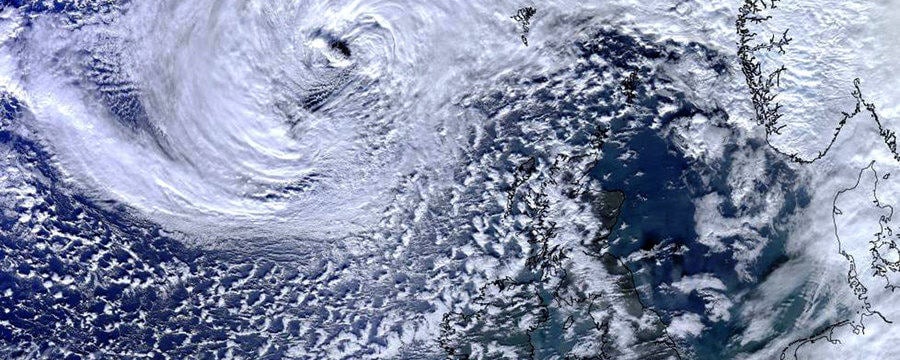Understanding Weather Fronts and Balloon Launches
Weather fronts are boundaries between two different air masses, and tend to be the location of a lot of cloud and rain. When we look at weather maps there is a temptation to think of fronts as vertical boundaries, like very tall fences, separating the warm and cold air masses. However, as the diagrams in the article showed, fronts have a considerable slope in the vertical. In fact, with slopes ranging from about 1:50 to 1:200, the slope of fronts is so shallow that we could almost think of fronts as horizontal boundaries, separating cold air below the front from warm air above it.
In Figure 1 below, the blue line across the centre of the box has been drawn with a slope of approximately 1:100, sloping upwards from left to right. 1:100 is a fairly typical value for the slope of a front and as you can see, the slope is so shallow as to be barely perceptible. When diagrams showing a cross section through a front are drawn in books or articles the vertical scale is always exaggerated to make the slope look much steeper than it really is.
Figure 1: The blue line across the box has been drawn with a slope of approximately 1:100 which is typical for the slope of a weather front.
Figure 2: (a) Skew-T log-P diagram for Nottingham at 1200 GMT on 29/2/16. Pressure is the vertical co-ordinate, decreasing upwards and labelled on the left hand side of the graph in mb . Actual heights (in metres) have been added in black text next to some of the pressure values. Blue lines of constant temperature slope from bottom left to top right and are labelled along the bottom of the diagram. The 2 black lines show the temperature (right hand line) and dew point temperature (left hand line) recorded by the weather balloon. The horizontal red line indicates the level of the frontal boundary between the cool dry air and the warm moist air. © University of Wyoming (b) Surface pressure and fronts map for 1200 GMT on 29/2/16. The blue dot shows the location of Nottingham.
Figure 3: (a) Skew-T log-P diagram for Camborne in Cornwall at 0000 GMT on 23 February 2016, in the same format as Figure 2(a)© University of Wyoming. (b) Met Office surface chart for the same time. The location of Camborne is shown by the blue dot. The vertical level of the front is marked by the horizontal red line.
Figure 3 shows a similar pair of diagrams to Figure 2, but in this case for 0000 GMT on 3 February 2016. In this case a cold front is located about 300km to the south of Camborne in Cornwall, shown by the blue dot on the weather map. Although the transition between the cool dry air and the warm moist air is not quite so clear-cut in this case, there is still a distinct change of air mass shown by the radiosonde temperature profile, with cool dry air below 650mb and warmer, moister air above this level. The change is most obvious in the dew-point temperature which increases from -40°C at 700mb to about -12°C at 650mb. In this case the slope of the front is approximately 1:80. This reflects the fact that cold fronts tend to have a steeper slope than warm fronts.
In both of the examples shown here the temperature and humidity increased with height as the balloon passed through the frontal boundary even though one was a warm front and the other was a cold front, because warm air is above cold air on both fronts. How then can we tell what type of front the balloon has passed through if we don’t have a weather map to show us? The answer is that with just the temperature and humidity information presented here we can’t – we would just know that there is a front of some type. A second balloon launch at a nearby location might help us work out which way the front was sloping. However, weather balloons also record the wind speed and direction as they ascend and changes in wind direction with height can tell us what type of front we were looking at. If the wind is veering with height (ie changing its direction in a clockwise sense around the compass) below the frontal boundary then the front is a warm front. If the wind is backing with height (ie changing its direction in an anticlockwise sense around the compass) then the front is a cold front.
In the warm front example here (for Nottingham) the wind near the surface was southerly but the wind at the level of the front was westerly, and so has veered with height. In the cold front example (Camborne) the wind at the surface was northerly but the wind at the level of the front was northwesterly so the wind has backed with height.
Share this
Come Rain or Shine: Understanding the Weather

Come Rain or Shine: Understanding the Weather


Reach your personal and professional goals
Unlock access to hundreds of expert online courses and degrees from top universities and educators to gain accredited qualifications and professional CV-building certificates.
Join over 18 million learners to launch, switch or build upon your career, all at your own pace, across a wide range of topic areas.
Register to receive updates
-
Create an account to receive our newsletter, course recommendations and promotions.
Register for free







